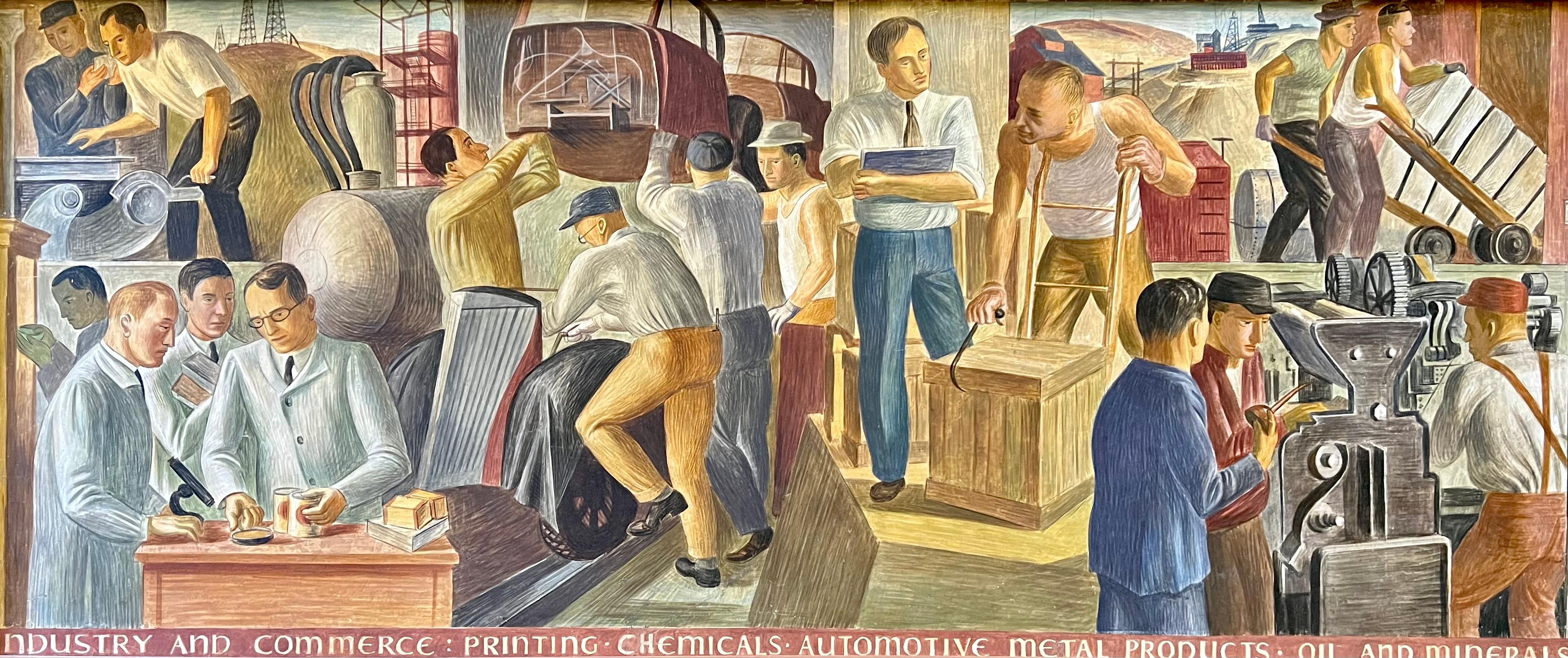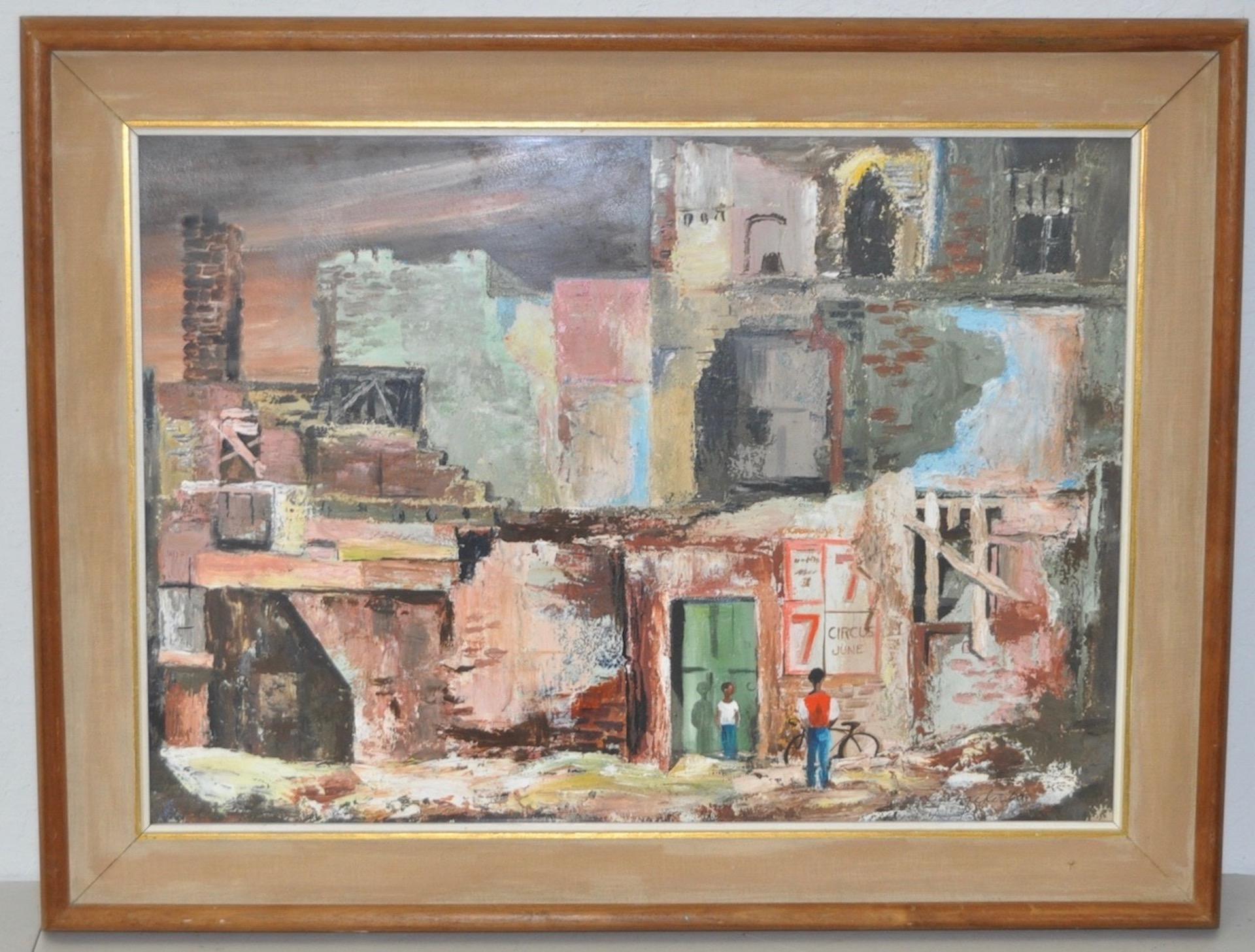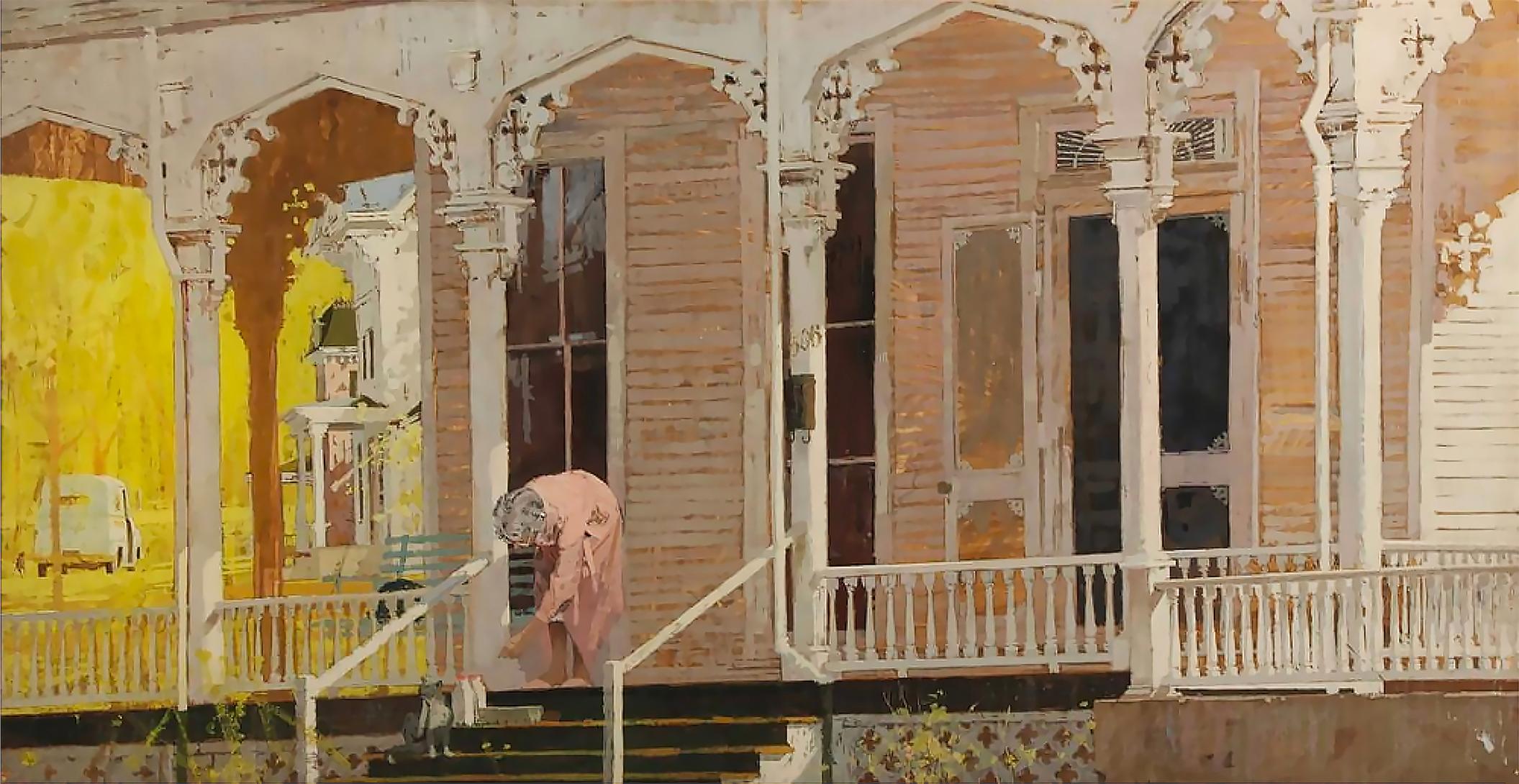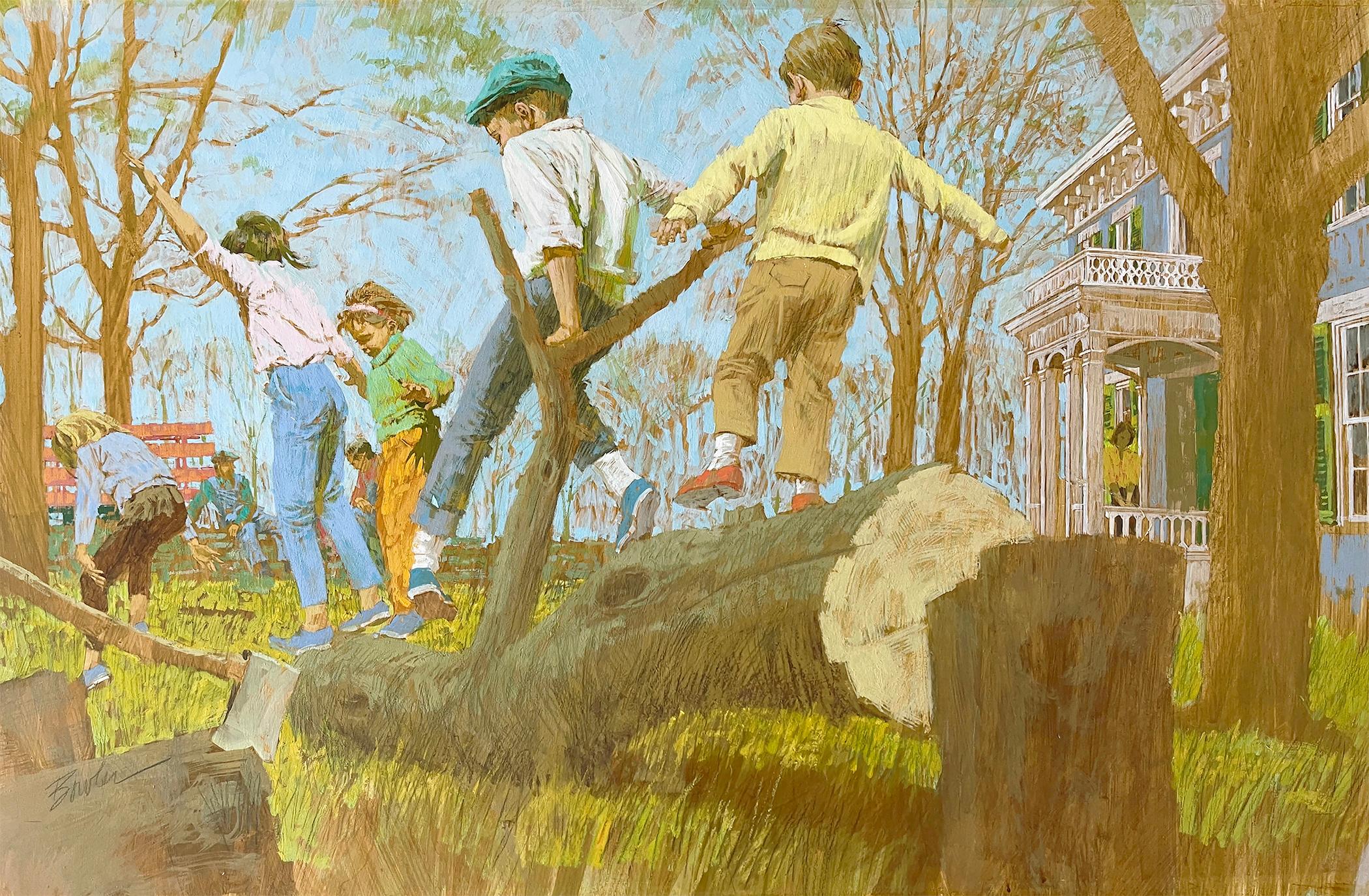Items Similar to "Woman Listening, " Honore Sharrer, Magical Realism Landscape with Flora & Figure
Want more images or videos?
Request additional images or videos from the seller
1 of 8
Honore Sharrer"Woman Listening, " Honore Sharrer, Magical Realism Landscape with Flora & Figure
About the Item
Honore Sharrer (1920 - 2009)
Woman Listening
Signed lower right
Caseine on paper
15 x 20 inches
Provenance:
Forum Gallery, New York
Private Collection
Honore Sharrer became celebrated as a prodigy of realism in 1944, when at age twenty-four, the Museum of Modern Art bought her study for a federal mural, Workers and Paintings (1943). At a time when most artists were moving into abstraction, she chose to paint small, meticulous panels, expressing her sympathy with the common people of this country.
Sharrer was born in West Point, New York. Her father was an army colonel, and her mother was an artist who had studied with Robert Henri. From her earliest years, Sharrer and her mother shared a companionable interest in art and spent weekends in the country painting and picnicking together. When she was fourteen, her father was stationed in Paris on the Ile St. Louis, and she attended her first life-drawing class at the Academie Colarossi with her mother. Much younger than the other students, she remembers being embarrassed by the nude model. Unlike the French girls at the lycee, Sharrer was free to roam the city unchaperoned, visiting the museums and absorbing the Old Masters at the Louvre.
When her father was transferred to San Diego, California, she attended the Bishops School, a private school in La Jolla. In her senior year, she won a $1000 prize from "American Magazine" in a national competition. Sharrer vividly remembers the powerful impression made on her by a fifteenth century painting by Hieronymus Bosch, "Christ Crowned with Thorns," at the San Diego Gallery of Fine Arts.
She identified with this traditional mode and decided to study at the Yale University art school, which was a stronghold of rigorous, traditional training before the arrival of Josef Albers and his Bauhaus-modern curriculum. After a year, Sharrer spent an additional year at the more free-wheeling California School of Fine Arts.
During World War II, she worked as a welder in a shipyard in Hoboken, New Jersey. There she closely observed the working-class types that she began to depict in her paintings. At a time when most artists were turning toward abstraction, Sharrer looked back to the realistic public art of the Federal Art Project of the 1930s, identifying strongly with its "human content and monumental form." She entered competitions for government post offices, and her mural study for the Worcester, Massachusetts, post office brought her to the attention of Lincoln Kirsten, who bought the study for the Museum of Modern Art.
After creating several small paintings, rendered like the works of Flemish and early Renaissance masters (Man at the Fountain (1948)), Sharrer embarked on an ambitious polyptych made up of five panels, entitled A Tribute to the American Working People (1951). Shown at Knoedlers Gallery in 1951, this work has recently been in the Sara Roby Foundation collection in New York. Although small in size, it is monumental in conception. Organized like a Renaissance altarpiece, A Tribute presents pictures of everyday America, -a worker in front of a factory, a schoolteacher and her class, a country fair.
Sharrer has explained, "I conceive of the people of this painting as individuals with petty pretensions and commercial vulgarities, but despite this crust of stereotype, they are the vital determining majority in which the cycle of birth, marriage, struggle, and death always seem to be pared down to elemental energy and simplicity of purpose". Four and a half years of arduous effort, and over four hundred photographs and sketches were applied to the research and execution of this work. She spent an entire day in an elementary school classroom just to study a particular kind of gesture, -of friendly play between a white child and a black child. The complex drawings were traced onto gesso panels and rendered in a technique so meticulous that painting one eye took her an entire day.
In addition to receiving major articles in Life and Art News, Sharrer exhibited in "Fourteen Americans" at the Museum of Modern Art and won various awards.
Between 1951 and 1969, during the wave of abstract art, she retreated into comparative isolation on her farm in Rochester, New York, where she lives and works in seclusion. She has been married since 1947 to Perez Zagorin, a history professor, and has one son.
Emerging after this hiatus, Sharrer showed larger satirical works, which were described in Arts (April 1969) as "devastating examples of social, political, and religious satire". "The Last Supper" is shown as the Mad-Hatters tea party. Lecherous old men, fully dressed monkeys, and fornicating dogs were part of the mélange, which was painted in a looser style.
In 1972, her painting "Leda and the Dwarf", won the Childe Hassam purchase prize from the American Academy of Arts and Letters. In 1978, "A Tribute to the American Working People" was sent to the U.S.S.R. in a major exhibition of American paintings selected by the Metropolitan Museum of Art.
- Creator:Honore Sharrer (1920, American)
- Dimensions:Height: 16 in (40.64 cm)Width: 21 in (53.34 cm)
- Medium:
- Movement & Style:
- Period:
- Condition:
- Gallery Location:New York, NY
- Reference Number:1stDibs: LU1841211234962
About the Seller
5.0
Platinum Seller
These expertly vetted sellers are 1stDibs' most experienced sellers and are rated highest by our customers.
Established in 2021
1stDibs seller since 2022
59 sales on 1stDibs
Typical response time: <1 hour
- ShippingRetrieving quote...Ships From: Larchmont, NY
- Return PolicyA return for this item may be initiated within 3 days of delivery.
More From This SellerView All
- "Tully Lumber Mill, Orange, Massachusetts, " Dorothy Eaton, WPA Factory RuralLocated in New York, NYDorothy Eaton Tully Lumber Mill, Orange, Massachusetts, 1935 Signed and dated lower right Oil on canvas 17 1/2 x 23 1/2 inches Dorothy Eaton was born in East Orange, New Jersey in 1893. She studied at Smith College...Category
1930s American Realist Landscape Paintings
MaterialsCanvas, Oil
- "Playground, Carl Schurz Park" George Picken, New York City, East River, UES WPABy George PickenLocated in New York, NYGeorge Picken Playground, Carl Schurz Park, 1938 Signed and dated lower left Oil on canvas 28 x 36 inches Provenance: Estate of the artist A native New Yorker, George Picken was born in 1898. His father, an artist and photographer, emigrated from Scotland; his mother came from Wales. They joined other European immigrants settling in New York City’s Hell’s Kitchen. Picken enlisted in the army during World War I and saw action at Verdun. After the war, he stayed in France and like many Americans returning from the vibrant Paris art scene, was inspired by the radical movement known as Impressionism. Upon his return Picken decided to follow in his father’s footsteps and become an artist. George began his studies in 1919 at the Art Students League during Robert Henri, Max Weber, and John Sloan’s tenure. There he took classes in studio art, illustration, and etching through 1923 studying extensively with George Bridgman. The writings of French philosopher Henri Bergson were widely circulated among the artistic community and looking at Picken’s early paintings one cannot help but wonder if as a young artist he was influenced by Bergson’s ideas. Bergson said, "[There are] two profoundly different ways of knowing a thing. The first implies that we move round the object; the second that we enter into it. The first depends on the point of view at which we are placed and on the symbols by which we express ourselves. The second neither depends on a point of view nor relies on any symbol. The first kind of knowledge may be said to stop at the relative; the second, in those cases where it is possible, to attain the absolute.” Picken’s recognition came early with showings of his work while he was a student. His drawings were published in the New Masses, a significant left-wing publication. The New York Public Library honored him with one-man shows in 1924 and 1928 and his work was included in group exhibitions at the Louis Comfort Tiffany Foundation, the Whitney Studio Club, Montross Gallery, and the Art Students League. During this time Picken married Viola Carton, one of Reginald Marsh’s models, and they lived in Westchester. Later they moved to Yorkville in Manhattan between 82nd street and East End Avenue where they began their family. Picken’s grandson Niles Jaeger recalled that, “Grandpa’s home and studio were in a five-story walk-up apartment, heated only by a coal stove. But there were wonderful views of the East River and the Queensborough Bridge...Category
1930s American Realist Landscape Paintings
MaterialsCanvas, Oil
- "The Beach" Nathan Hoffman, Brooklyn, New York, Sunny Day LandscapeLocated in New York, NYNathan Hoffman The Beach Estate stamped on the reverse Oil on artist's board 10 1/4 x 14 inches Provenance: Estate of the artist Born in Russia, the s...Category
1940s American Impressionist Landscape Paintings
MaterialsOil, Board
- "A Man in His Garden, " Emil Carlsen, Backyard and Barn Impressionist LandscapeBy Emil CarlsenLocated in New York, NYSoren Emil Carlsen (1848 - 1932) A Man in His Garden, 1893 Oil on canvas 28 3/4 x 35 1/2 inches Signed and dated lower right Provenance: The artist [1848-1932] Macbeth Gallery, New ...Category
1890s American Impressionist Landscape Paintings
MaterialsCanvas, Oil
- "The Green Parasol, " Henry Hannig, American Impressionist, Woman in Beach SceneBy Henry HannigLocated in New York, NYHenry Charles Hannig (1883 - 1948) The Green Parasol Oil on canvas mounted on board 6 x 7 3/4 inches Provenance: R.H. Love Galleries, Chicago, Illinois Private Collection, Lake Orion, Michigan Hannig, born in Hirschberg, Germany on 27 February 1883, came to America with his parents at the age of seven. He attended school in the southwest suburbs before the family settled in Chicago. Young Henry enrolled in the Chicago Academy of Fine Arts where Lawton Parker became his mentor. He made ends meet by working in industrial design and illustration. By 1908 he was a pupil in the School of the Art Institute of Chicago where students followed the traditional European drawing curriculum, beginning with the copying of master engravings and drawing after plaster casts, then concentrating on the nude figure. Students worked toward the goal of winning various academic prizes. One of Hannig's fellow students was Louis Ritman...Category
1910s American Impressionist Figurative Paintings
MaterialsCanvas, Oil, Board
- Saratoga Springs Racetrack, Summer Grandstand Crowd, Horse BettorsBy Anne DiggoryLocated in New York, NYAnne Diggory (b. 1951) Grandstand Crowd, Saratoga Springs Racecourse, New York Oil on panel 26 x 31 inches Initialed lower right: APD Anne Diggory lives ...Category
1970s Contemporary Figurative Paintings
MaterialsOil, Panel
You May Also Like
- Industry and CommerceLocated in Los Angeles, CAThis mural study is part of our exhibition America Coast to Coast: Artists of the 1930s Industry and Commerce, 1936, tempera on panel, 16 ½ x 39 ½ inches, signed verso “John Ballat...Category
1930s American Realist Figurative Paintings
MaterialsTempera
- Colliers Magazine 1947 American Scene Social Realism Modern Families in the SnowLocated in New York, NYColliers Magazine 1947 American Scene Social Realism Modern Families in the Snow Katherine Wiggins (American 20th Century) "The Shrimp" 20 x 24 inches Egg tempera on masonite. c. 1...Category
1940s American Realist Figurative Paintings
MaterialsEgg Tempera, Masonite
- "The Grinder", Egg Tempera PaintingBy Kevin WeckbachLocated in Denver, COKevin Weckbach's (US based) "The Grinder" is an original, hand made egg tempera painting that depicts an industrial Gristmill made up of metal buildings, a elevator and a grain silo ...Category
2010s American Realist Landscape Paintings
MaterialsEgg Tempera
- Maryn Hunzeker "Explorers" Original Casein Painting c.1960By Maryn HunzekerLocated in San Francisco, CAMaryn Hunzeker "Explorers" Original Casein Painting c.1960 Fantastic mid modern painting by noted artist Maryn Hunzeker. Created with casein on panel. Dimensions 26" x 18 1/4". The...Category
Mid-20th Century Impressionist Figurative Paintings
MaterialsCasein, Panel
- Woman on Porch Feed Her Cats at Early Morning, Mid CenturyBy Joe BowlerLocated in Miami, FLA milk truck is seen caressed in the golden light of early morning as a woman bends down to feed her cat. The artist depicts a precious moment as an older woman reaching down to pick...Category
1960s Post-Impressionist Figurative Paintings
MaterialsCasein
- The Tree Cutters - Children Playing on a Fallen Tree - Saturday Evening Post?By Joe BowlerLocated in Miami, FLThis golden age of illustration work was most likely done for an interior story illustration for the Saturday Evening Post. Joe Bowler paints it in a loose but academically correct ...Category
1960s Post-Impressionist Landscape Paintings
MaterialsGesso, Casein, Wood Panel
Recently Viewed
View AllMore Ways To Browse
Magical Art
Early American Figure
Landscape Mural
California Woman Artists Landscape
Vintage Country Fair
Landscape American Realism
San Diego Landscape
Monumental Landscape Painting
Woman Into Man
Vintage Working Woman
Old World Masters Landscape
California Realism
Realism Painting California
French Old Master Landscape
Flemish Landscape
Old Master Style Landscapes
American Landscape 1920s
Strong Vintage Woman





